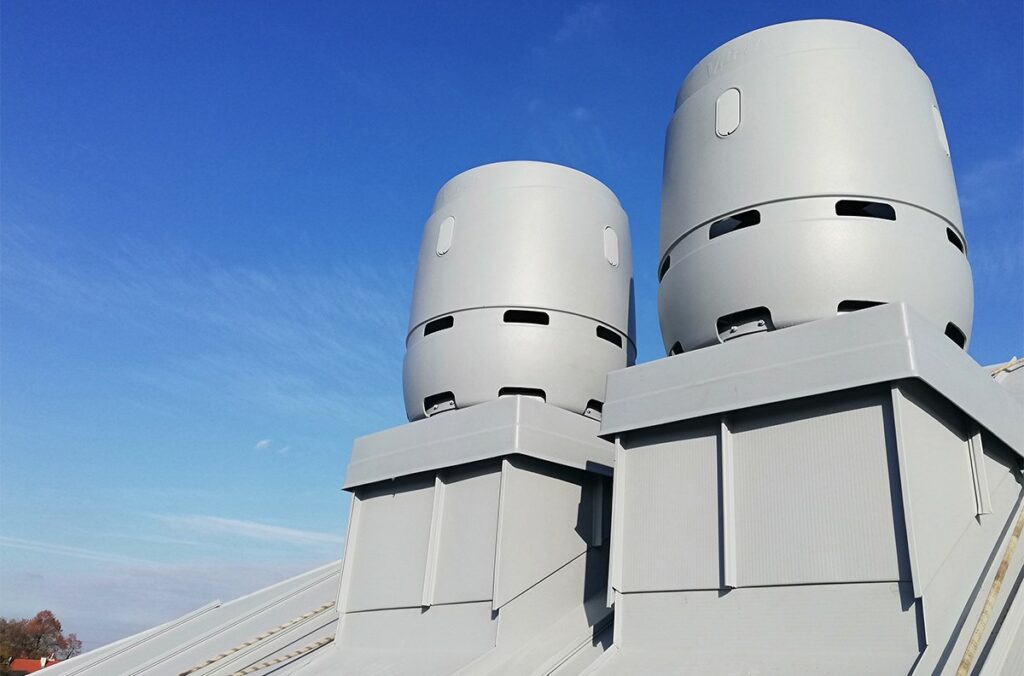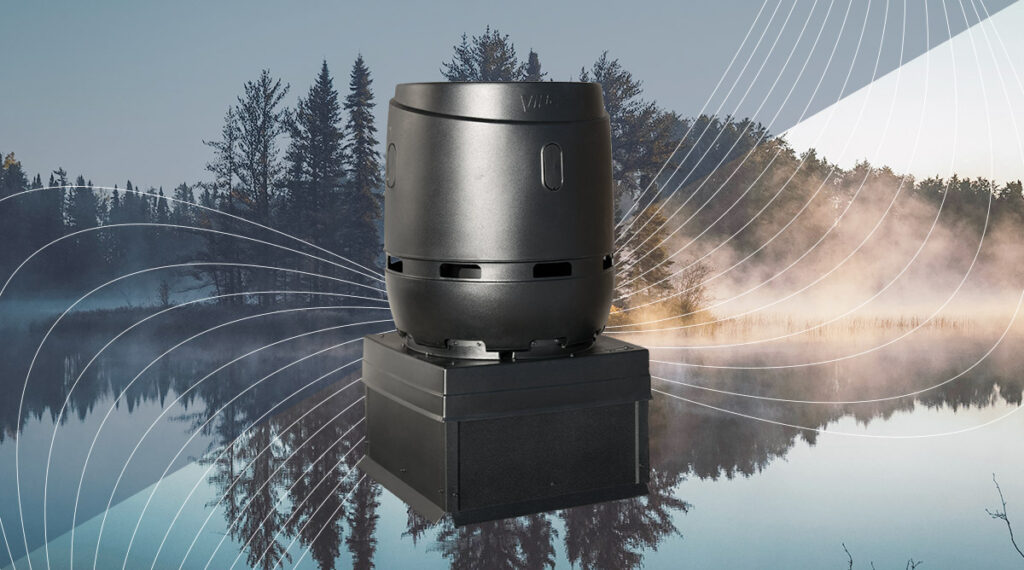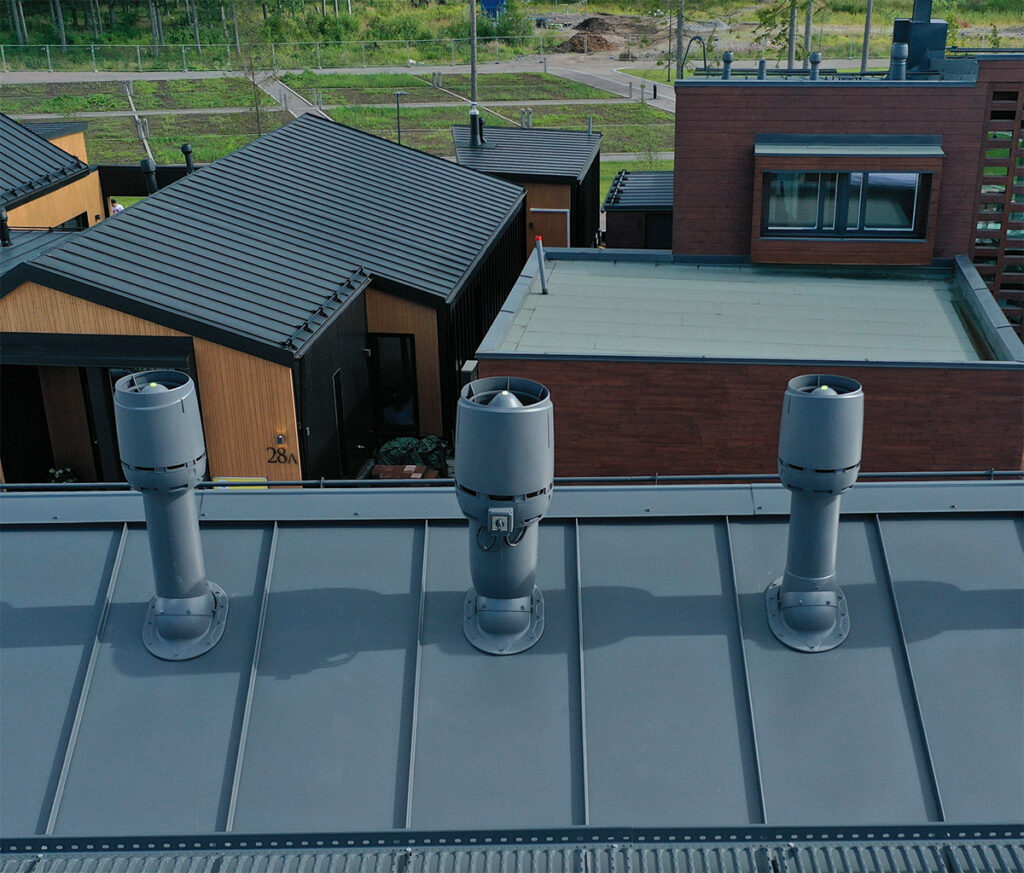Save hundreds of euros a year with VILPE’s energy efficient exhaust vents

Skillful HVAC planning is a key factor when designing energy efficient buildings, as making the correct product choices will reduce energy consumption significantly. Saving energy has positive effects on both the environment and your electricity bill.
Exhaust vent pressure loss affects energy consumption
An HVAC planner can reduce a building’s energy consumption by choosing energy efficient ventilation units and exhaust vents. If these exhaust vents have a low level of pressure loss, they can significantly reduce the energy consumption of the building’s ventilation unit(s). For example, the VILPE 315/400S and 500/630S FLOW are excellent exhaust vents thanks to their low levels of pressure loss. Over a period of five years, this can result in savings of thousands of euros compared to products with a higher level of pressure loss.
Both duct sizes ⌀ 315 and 400 mm have the same sized cowl. Likewise, the cowls of duct sizes ⌀ 500 and 630 mm are the same size. When a product with a 315 mm duct is used with the same sized cowl as a product with a 400 mm duct, it causes a significant difference in pressure loss and results in large energy savings.
The VILPE 315/400S & 500/630S FLOW may sometimes be larger than other products. However, they are made of polyethylene, which makes them lightweight. These new FLOW products are worth choosing because of how low the resulting energy consumption is, and the consequently significant reduction in electricity bills.
In addition to energy savings, another advantage of using low pressure exhaust vents is that they enable more product choices when selecting ventilation units. As shown in calculations, the specific fan power (SFP) is 1,69 kW/(m³/s) when using the VILPE 315S FLOW, which demonstrates how the specific fan power is in accordance with the Finnish Ministry of the Environment’s regulations.
Take a look at the calculations below and see how much electricity and money you’ll save with energy efficient exhaust vents. In the examples, the exhaust ventilation duct has a pressure loss of 50 Pa which includes both the VILPE FLOW products and ventilation ducts.
Learn more about VILPE’s Green Roof Solutions.
Example 1. VILPE 315S FLOW
The air flow in this example is 0,7 m3/s. The pressure loss of the exhaust ventilation ducts and the VILPE 315S FLOW exhaust vent is 50 Pa. This has been compared to a product A with a pressure loss of 168 Pa.
The electricity consumption of the ventilation unit with VILPE 315S FLOW is 10363 kWh/year (0,7 m3/s * SFP 1,69 (kW/(m3/s)) *operation hours 8760 h = 10363).
The ventilation unit with a product A uses more energy because it has a higher pressure loss than the VILPE 315S FLOW 11406 kWh/year (0,7 m3/s * SFP 1,86 *operation hours 8760 = 11406).
The difference in electricity consumption is 11405,52 kWh – 10363,083 kWh = 1042,44 kWh/year (Note that the numbers in column kWh/year have been rounded to the nearest whole number).
The electricity price is 0,12 €/kWh*1042 kWh =125,04 € annually. Over a period of five years, it will cost 125,04 € * 5 = 625,2 €.
In this example, the total energy savings resulting from the VILPE 315S FLOW are worth 600 euros over five years.
If you then compare the VILPE 315S FLOW to a product B with an even higher pressure loss of 234 Pa and with the same air flow, the difference in energy consumption is nearly a thousand euros (993,38 €) over five years.
The differences in energy consumption are highlighted specifically for product sizes of 315 and 500 mm; the reason for this is that they have the same cowl sizes as products of 400 and 630 mm.
| Air flow | Electricity price €/kWh | Time period | |||||||
| m3/s | Pa | SFP (kW/(m3/s)) | Operation hours | kwh/year | Difference (kWh) | Difference % | 0,12 | Difference over 5 years | |
| VILPE 315S FLOW | 0,7 | 50 | 1,69 | 8760 | 10363 | ||||
| Product A | 0,7 | 168 | 1,86 | 8760 | 11406 | 1042 | 10,1 | 125 | 625 |
| Product B | 0,7 | 234 | 1,96 | 8760 | 12019 | 1656 | 16,0 | 199 | 993 |
Example 2. VILPE 500S FLOW
The air flow in this example is 1,7 m3/s. The pressure loss of the exhaust ventilation ducts and the VILPE 500S FLOW exhaust vent is 50 Pa. This has been compared to a product C with a pressure loss of 152 Pa.
The electricity consumption of the ventilation unit with the VILPE 500S FLOW is 23 678 kWh/year (1,7 m3/s * SFP 1,59 (kW/(m3/s)) *operation hours 8760 h = 23 678).
The ventilation unit with product C uses more energy because it has a higher pressure loss than the VILPE 500S FLOW 25912 kWh/year (1,7 m3/s * SFP 1,74 *operation hours 8760 = 25912).
The difference in electricity consumption is 25912 kWh –23 678 kWh = 2234 kWh/year
The electricity price is 0,12 €/kWh*2234 kWh =268 € annually. Over a period of five years, it will cost 268 € * 5 = 1340 €.
In this example, the total energy savings resulting from the VILPE 500S FLOW are worth 1340 euros over five years.
If you then compare the VILPE 500S FLOW to a product D with an even higher pressure loss of 183 Pa and with the same air flow, the difference in energy consumption is nearly 1700 euros (1697 €) over five years.
The differences in energy consumption are highlighted specifically for product sizes of 315 and 500 mm; the reason for this is that they have the same cowl sizes as products of 400 and 630 mm.
| Air flow | Electricity price €/kWh | Time period | |||||||
| m3/s | Pa | SFP (kW/(m3/s)) | Operation hours | KWh/year | Difference (kWh) | Difference % | 0,12 | Difference over 5 years | |
| VILPE 500S FLOW | 1,7 | 50 | 1,59 | 8760 | 23678 | ||||
| Product C | 1,7 | 152 | 1,74 | 8760 | 25912 | 2234 | 9,4 | 268 | 1340 |
| Product D | 1,7 | 183 | 1,78 | 8760 | 26508 | 2829 | 11,9 | 340 | 1698 |
Example 3. VILPE 630S FLOW
The air flow in this example is 1,8 m3/s. The pressure loss of the exhaust ventilation ducts and the VILPE 630S FLOW exhaust vent is 50 Pa. This has been compared to a product E with a pressure loss of 67 Pa.
The electricity consumption of the ventilation unit with VILPE 630S FLOW is 25 544 kWh/year (1,8 m3/s * SFP 1,62 (kW/(m3/s)) *operation hours 8760 h =25 544).
Ventilation unit with product E uses more energy because it has a higher pressure loss than the VILPE 630S FLOW 25702 kWh/year (1,8 m3/s * SFP 1,63 *operation hours 8760 = 25702).
The difference in electricity consumption is 25702 kWh –25544 kWh = 158 kWh/year
The electricity price is 0,12 €/kWh*158 kWh =18,92 € annually. Over a period of five years, it will cost 18,9 € * 5 = 94,6 €.
In this example, the total energy savings resulting from the VILPE 630S FLOW are worth 95 euros over five years.
If you then compare the VILPE 630S FLOW to a product F with an even higher pressure loss of 72 Pa and with the same air flow, the difference in energy consumption is nearly 200 euros (189 €) over five years.
The differences in energy consumption are highlighted specifically for product sizes of 315 and 500 mm; the reason for this is that they have the same cowl sizes as products of 400 and 630 mm.
| Air flow | Electricity price €/kWh | Time period | |||||||
| m3/s | Pa | SFP (kW/(m3/s)) | Operation hours | KWh/year | Difference (kWh) | Difference % | 0,12 | Difference over 5 years | |
| VILPE 630S FLOW | 1,8 | 50 | 1,62 | 8760 | 25544 | ||||
| Product E | 1,8 | 67 | 1,63 | 8760 | 25702 | 158 | 0,6 | 18,92 | 95 |
| Product F | 1,8 | 72 | 1,64 | 8760 | 25860 | 315 | 1,2 | 37,84 | 189 |
Watch this video to learn more about the VILPE FLOW.



